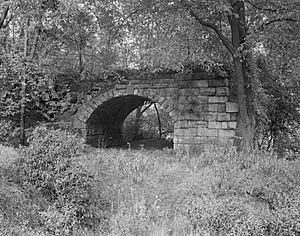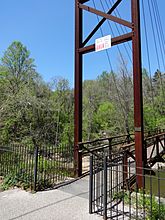Patterson Viaduct facts for kids
Quick facts for kids Patterson Viaduct |
|
|---|---|

Patterson Viaduct Ruins, 1970
|
|
| Coordinates | 39°14′56″N 76°45′53″W / 39.248889°N 76.764722°W |
|
Patterson Viaduct Ruins
|
|
| Lua error in Module:Location_map at line 420: attempt to index field 'wikibase' (a nil value). | |
| Nearest city | Ilchester, Maryland |
| Area | 2 acres (0.81 ha) |
| Built | 1829 |
| Built by | Wever, Caspar; McCartney, John |
| Architectural style | Masonry Arch Bridge |
| NRHP reference No. | 76002221 |
| Added to NRHP | June 3, 1976 |
| Crosses | Patapsco River (before 1868) |
| Locale | Ilchester, Maryland |
| Official name | Patterson Viaduct |
| Characteristics | |
| Design | Arch bridge |
| Total length | 360 feet (110 m) |
| Longest span | 55 feet (17 m) |
| Clearance below | 43 feet (13 m) |
| History | |
| Opened | December 1829 |
| Closed | 1868 |
The Patterson Viaduct was built by the Baltimore and Ohio Railroad (B&O) as part of its Old Main Line during May to December 1829. The viaduct spanned the Patapsco River at Ilchester, Maryland. It was heavily damaged by a flood in 1866 and subsequently replaced with other structures.
History and design
Original bridge
The viaduct was constructed during the first building phase of the railroad, which extended from Baltimore, Maryland, to Ellicott's Mills (today's Ellicott City). The Patterson span at Ilchester, the third initial stone bridge built for the B&O, was similar in construction to the company's first bridge, the nearby Carrollton Viaduct further east spanning the Gwynns Falls and was named for B&O director and well known civic leader and merchant William Patterson who also donated land for Patterson Park in east Baltimore. It was designed by Caspar Wever and built under the supervision of John McCartney, one of Wever's assistants. McCartney's good work on the Patterson Viaduct was later rewarded with the contract to build the longer curving 1833-35 Thomas Viaduct downstream over the upper Patapsco River at Relay. The other span of the first four historic stone and masonry bridges on the B. & O. line was the Oliver Viaduct, also built over the upper Patapsco at Ellicott Mills and adjacent Washington Road.
The bridge was constructed of granite blocks and was about 360 feet (110 m) long, rising about 43 feet (13 m) above its foundations. It had four graduated arches: two of 55 feet (17 m) chord length each and two of 20 feet (6 m) chord length each. The two smaller side arches allowed the passage of two county roadways, one on each side of the river. The exterior surfaces of the granite blocks were undressed, or rusticated.
Patterson ceremonially opened the viaduct on December 4, 1829, a year and a half after the First Stone was laid beginning construction on the line, the first in America. In 1830, The viaduct was part of the route used by the B&O's first horse-drawn carriage train to Ellicott's Mills inaugurating railway traffic.
Second bridge
The viaduct was almost totally destroyed in a major massive 1868 flood which devastated and wiped out most of the numerous stone mills and industrial structures lining the river. A single-span Bollman Truss of cast and wrought iron by Wendel Bollman was built into the west abutment in 1869 incorporated the original roadway arch and upstream wing wall.
The Bollman design was supplanted by another bridge before the railroad was realigned a little ways upstream 400 feet (120 m) in 1902–03 with the opening of the Ilchester Tunnel. According to local folklore, Ilchester Tunnel is haunted by Peeping Tom.
The Patterson Viaduct Ruins were listed on the National Register of Historic Places on June 3, 1976.
Third bridge
Today, all that remains at the original Patterson Viaduct is the single masonry roadway side arch of the 1829 construction on the west bank of the Patapsco and the stone abutment on the east bank, just south of the present railroad bridge. In 2006, a cable-stayed footbridge carrying the Grist Mill Trail, with a design that echoes the historic architecture and engineering of a Bollman Bridge, was added atop the abutments.



